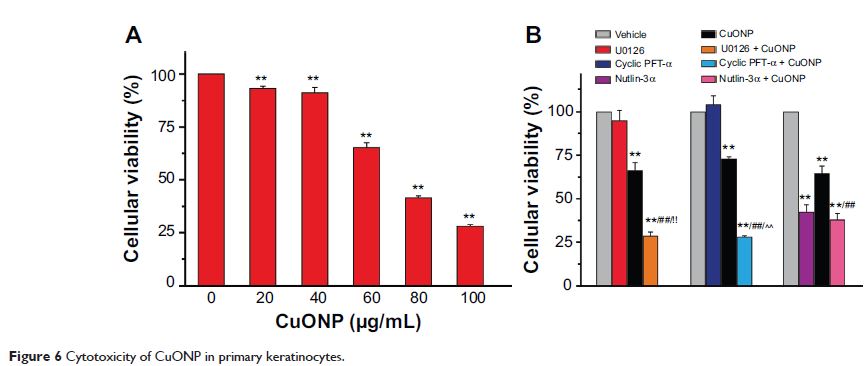109229
论文已发表
注册即可获取德孚的最新动态
IF 收录期刊
- 3.4 Breast Cancer (Dove Med Press)
- 3.2 Clin Epidemiol
- 2.6 Cancer Manag Res
- 2.9 Infect Drug Resist
- 3.7 Clin Interv Aging
- 5.1 Drug Des Dev Ther
- 3.1 Int J Chronic Obstr
- 6.6 Int J Nanomed
- 2.6 Int J Women's Health
- 2.9 Neuropsych Dis Treat
- 2.8 OncoTargets Ther
- 2.0 Patient Prefer Adher
- 2.2 Ther Clin Risk Manag
- 2.5 J Pain Res
- 3.0 Diabet Metab Synd Ob
- 3.2 Psychol Res Behav Ma
- 3.4 Nat Sci Sleep
- 1.8 Pharmgenomics Pers Med
- 2.0 Risk Manag Healthc Policy
- 4.1 J Inflamm Res
- 2.0 Int J Gen Med
- 3.4 J Hepatocell Carcinoma
- 3.0 J Asthma Allergy
- 2.2 Clin Cosmet Investig Dermatol
- 2.4 J Multidiscip Healthc

已发表论文
Erk 和 p53 蛋白激活调控角质形成细胞以及成纤维细胞内氧化铜纳米颗粒诱导的细胞毒性
Authors Luo C, Li Y, Yang L, Zheng Y, Long J, Jia J, Xiao S, Liu J
Published Date October 2014 Volume 2014:9(1) Pages 4763—4772
DOI http://dx.doi.org/10.2147/IJN.S67688
Received 13 May 2014, Accepted 15 August 2014, Published 10 October 2014
Approved for publication by Dr Lei Yang
Abstract: Copper oxide nanoparticles (CuONP) have attracted increasing attention due to their unique properties and have been extensively utilized in industrial and commercial applications. For example, their antimicrobial capability endows CuONP with applications in dressings and textiles against bacterial infections. Along with the wide applications, concerns about the possible effects of CuONP on humans are also increasing. It is crucial to evaluate the safety and impact of CuONP on humans, and especially the skin, prior to their practical application. The potential toxicity of CuONP to skin keratinocytes has been reported recently. However, the underlying mechanism of toxicity in skin cells has remained unclear. In the present work, we explored the possible mechanism of the cytotoxicity of CuONP in HaCaT human keratinocytes and mouse embryonic fibroblasts (MEF). CuONP exposure induced viability loss, migration inhibition, and G2/M phase cycle arrest in both cell types. CuONP significantly induced mitogen-activated protein kinase (extracellular signal-regulated kinase [Erk], p38, and c-Jun N-terminal kinase [JNK]) activation in dose- and time-dependent manners. U0126 (an inhibitor of Erk), but not SB 239063 (an inhibitor of p38) or SP600125 (an inhibitor of JNK), enhanced CuONP-induced viability loss. CuONP also induced decreases in p53 and p-p53 levels in both cell types. Cyclic pifithrin-α, an inhibitor of p53 transcriptional activity, enhanced CuONP-induced viability loss. Nutlin-3α, a p53 stabilizer, prevented CuONP-induced viability loss in HaCaT cells, but not in MEF cells, due to the inherent toxicity of nutlin-3α to MEF. Moreover, the experiments on primary keratinocytes are in accordance with the conclusions acquired from HaCaT and MEF cells. These data demonstrate that the activation of Erk and p53 plays an important role in CuONP-induced cytotoxicity, and agents that preserve Erk or p53 activation may prevent CuONP-induced cytotoxicity.
Keywords: cell cycle arrest, CuONP, MAPK, nutlin-3α, cyclic pifithrin-α
Keywords: cell cycle arrest, CuONP, MAPK, nutlin-3α, cyclic pifithrin-α
